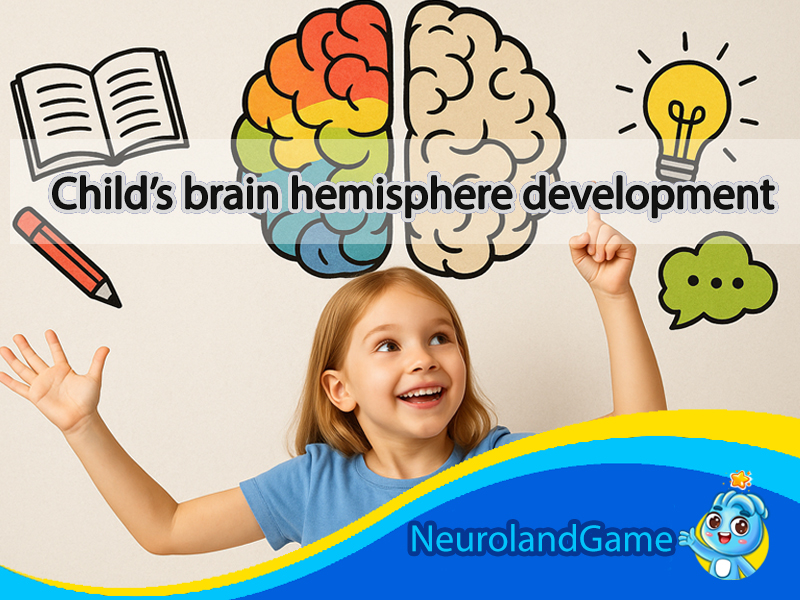Child’s brain hemisphere development: Proven Activities for Balanced Brain Development
Did you know that supporting brain hemisphere development in children can greatly improve their learning, focus, and emotional growth? A child’s brain has two powerful sides—the left and right hemispheres—that must work together in harmony. With the right combination of movement, play, and daily routines, you can strengthen your child’s brain in fun and natural ways. In this article of Neuroland, we’ll explore simple yet effective cross-lateral activities, creative exercises, and everyday habits to help your child develop a balanced and healthy brain.
Understanding the Two Hemispheres
Left hemisphere: Handles logical thinking, language processing, sequencing, and analytical tasks—like math and grammar.
Right hemisphere: Governs creativity, spatial awareness, emotions, and holistic thinking.
Effective brain development comes from nurturing both sides and promoting interhemispheric communication—the transfer of information between hemispheres via the corpus callosum.
Why Strengthening Both Brain Sides Matters
Enhanced learning & academic performance: Balanced hemisphere activity boosts reading, writing, logical analysis, and creative problem-solving.
Improved coordination and motor skills: Especially through midline crossing exercises, which foster bodily coordination and support cognitive tasks like reading.
Emotional resilience & focus: Right-left brain synergy helps manage emotions and stay attentive under stress.
Effective Activities to Strengthen Children’s Brain Hemispheres
1. Cross-Lateral Movements & Midline Crossing
- Cross-crawls: Touch your right elbow to your left knee, then alternate sides.
- Arm scissors: Extend arms side-to-side in a ‘T,’ then cross one arm over the other.
- One-foot walk: Step one foot directly in front of the other to challenge balance.
- Hopscotch & marching games: Encourage body-side coordination to connect hemispheres.
2. Creative and Sensory-Rich Right-Brain Exercises
- Music, rhythm, dance & singing foster creativity, spatial reasoning, and emotional IQ.
- Drawing, coloring, stories, and imaginative play boost holistic thinking and creative expression.
- Sensory play (clay, sand, textured items) stimulates the senses and language development.
3. Structured Left-Brain Activities
- Puzzles, brain teasers, math games and scavenger hunts sharpen logic, concentration, and analytical thinking.
- Reading aloud, writing short stories, and learning new vocabulary support linguistic and analytical skills.
4. Mindfulness & Meditation
- Simple breathing exercises and guided meditations help children balance brain activity and boost emotional control.
5. Everyday Brain-Boosting Routines
- Narrated interaction: Describe your daily tasks (“I’m pouring juice”) to improve language and mind awareness.
- Repetition: Reading favorite stories enhances vocabulary, memory, and pattern recognition.
- Handling mistakes: Show calm problem-solving to help children build resilience and executive function.
Design a Whole-Brain Development Routine
| Time | Activity | Focus | Benefits |
|---|---|---|---|
| Morning | Cross-crawl warm-up | Coordination via midline crossing | Improves motor control, hemispheric communication |
| Afternoon | Creative play (art/music) | Right-brain creativity | Boosts imagination and emotional processing |
| Evening | Puzzle time + story reading | Left-brain logic & language | Develops analytical thinking and reading skills |
| Night | Guided deep-breathing | Balanced hemispheric activity | Promotes calm and focus before bed |
Final Takeaways
To strengthen a child’s brain hemispheres, blend motor, sensory, creative, and structured activities into everyday play. Focus on:
-
Cross-lateral exercises for physical coordination and hemisphere connectivity
-
Right-brain boosting through creative, sensory play
-
Left-brain exercises like puzzles and language tasks
-
Daily routines supporting learning, emotional intelligence, and resilience
By weaving these brain hemisphere development strategies into playtime and daily life, kids build stronger neural pathways across both hemispheres—leading to smarter, faster learning, better coordination, and healthier emotional growth.







